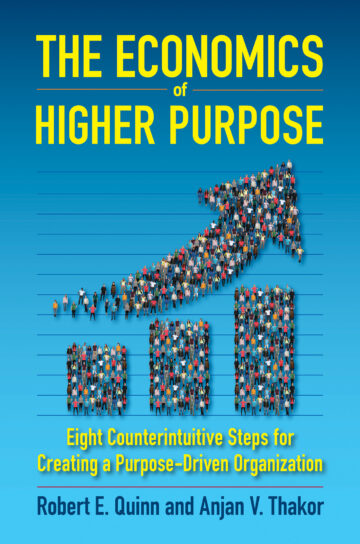About four years ago, I became interested in the topic of higher purpose, purely by chance. Bob Quinn, a good friend and former colleague at the University of Michigan’s business school, had just returned with his wife from a three-year stay in Australia. Bob had been asked to lead a Mormon church there. He described his stay as the greatest experience of his life, because “we created an organization of higher purpose.”
Nothing he said about his organization made sense to me as an economist. Everything seemed to violate the basic economic principles on how to create incentives for desired behavior in organizations. After a long conversation, we decided to research whether organizations of higher purpose existed outside places of worship and, if so, how they operated. And what impact did this have on their business results?

The Economics of Higher Purpose
Eight Counterintuitive Steps For Creating a Purpose-Driven Organization
We wrote a theoretical paper that introduced organizational higher purpose into an economic model. Over a two-year period, we conducted about 40 in-depth interviews of leaders from for-profits, nonprofits, private firms and public firms to learn their approaches to the issue. After analyzing our data, we published an article in the Harvard Business Review as well as a book, The Economics of Higher Purpose, in 2019.
In our writings, we define organizational higher purpose as a (prosocial) contribution goal that transcends the usual business goals, such as shareholder value and profit maximization, yet acts as the arbiter of all business decisions. An organization of higher purpose is a social system in which the greater good has been envisioned, articulated and authenticated.
Like all organizations, one with a higher purpose is a cauldron of conflict. But because the higher purpose is the arbiter of all decisions, people find meaning in their work and in their relationships in spite of the conflicts. They strive to transcend their egos and sacrifice for the common good. Despite constant pressures to regress to the norm, people interact with one another with respect and engage in constructive confrontation.
The employees have a win-win mentality, and positive peer pressure emerges to support high levels of collaboration. Leadership flows from the top down and also emerges from the bottom up. Meetings are generative, and members of the organization co-create the future. Employees believe they work in an organization of excellence, and customers and other external constituents are drawn to and confirm the excellence by joining in the co-creation of the organization’s future.
When adopting a higher purpose, the organization often makes short-term economic sacrifices but benefits from long-term economic gains. In organization after organization, we found that if the higher purpose was authentic — that is, the leader truly believed in the purpose and it was not a public relations gimmick — then the impact on the economic outcomes (profits, market-share growth, employee engagement, customer satisfaction, shareholder value) was significantly positive.
But if purpose is undertaken solely for economic gain, it loses authenticity and credibility and fails to produce positive economic outcomes. Cynicism sets in, and employees view it as an exercise that is no more meaningful than the countless posters on company walls about values. As a result, employees fail to connect with their work.
We also uncovered two other rather surprising findings: Most organizations that had an effective higher purpose discovered it; they didn’t invent it. And many of these discoveries occurred during times of deep crisis, some existential, when the organization had plenty of other distractions, even possibly how to survive.
Our research enabled us to develop an eight-step process for organizations to effectively discover and implement their higher purpose:
- Envision a purpose-driven organization
- Discover the purpose
- Meet the need for authenticity (fidelity to the truth and genuine passion for the purpose)
- Turn the higher purpose into a constant arbiter of all business decisions
- Stimulate learning
- Turn mid-level managers into purpose-driven leaders
- Connect the people to the purpose
- Unleash the positive energizers
Our Harvard Business Review article and subsequent book explain these steps in detail, with numerous examples of real-world organizations. In the book, we also provide exercises organizations can do to begin the journey of finding and implementing higher purpose.


